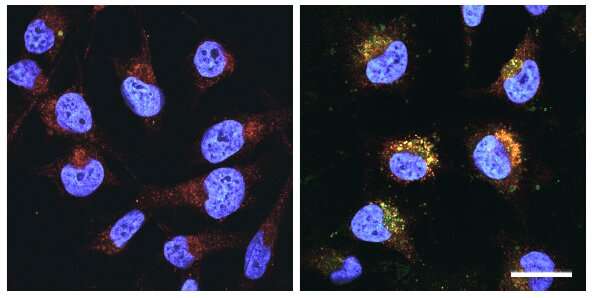Fatty acid length predicts Parkinson's disease risk

Whether or not someone develops Parkinson's disease may be a game of nanometers.
A recent study has demonstrated that chains of fatty acids in the lysosome just one-half nanometer longer than normal-length chains—less than half the diameter of a DNA molecule—were associated with a degenerative form of Gaucher disease, an inherited condition related to Parkinson's disease.
According to the study publishing in Proceedings of the National Academy of the Sciences (PNAS), the length of these fatty acid or lipid chains could explain why some patients with harmful mutations in the gene GBA1 never develop Parkinson's disease.
"The people who develop Parkinson's disease probably accumulate these long chains that are extra sticky and interact with alpha-synuclein," said Joseph Mazzulli, Ph.D., associate professor in the Ken and Ruth Davee Department of Neurology in the Division of Movement Disorders and senior author of the study. "We hypothesize that the ones who don't develop Parkinson's don't accumulate these long chains, and so are protected."
Mutations in GBA1 are the most common known genetic risk factor for Parkinson's disease. A single mutation in the gene leads to an approximately 10 percent chance of developing Parkinson's, but two mutations—one inherited from each parent—results in the lysosomal storage disorder Gaucher disease, characterized by a failure of the lysosome to dispose of glycosylated fatty acids and subsequent accumulation of those fatty acid chains.
Some but not all patients with Gaucher disease develop a form of the disorder similar to Parkinson's disease. This mirrors the uncertainty with which GBA1 mutations cause Parkinson's disease, so Mazzulli and his collaborators examined cellular models of Gaucher disease to elucidate the source of this unexplained risk.
Examining the lysosomes of these cells, the scientists discovered a particular family of lipids that are abnormally long—a difference of one-tenth to one-half nanometer—and which are especially neurotoxic. These lipids stimulate the formation of alpha-synuclein aggregates, clumps of misfolded proteins that are associated with Parkinson's disease symptoms, Mazzulli said.
Treating the cells with a drug that decreases the levels of long chain length lipids reduced alpha-synuclein aggregates and reversed the neurotoxic phenotype, confirming the long chain length was an operative factor.
Further, the scientists discovered that cathepsin-B, a protein that cuts synuclein in the lysosome, needs to be inactive in addition to the presence of long fatty acid chains in order to produce the neurotoxic phenotype. Inhibiting cathepsin-B in patient-derived neuron cultures blocked the protective effects of the lipid-reducing drug. This new discovery may explain the failure of a recent clinical trial for lipid-shortening drugs in patients with Parkinson's disease, Mazzulli said.
"We think that patients need to have an active cathepsin-B in order for these drugs to work," Mazzulli said. "This discovery may help to guide future clinical trials by screening for patients with functional cathepsin-B. Alternatively, combination therapies that activate cathepsin-B while reducing lipids may provide therapeutic benefit."
Next, Mazzulli said he plans to examine these lipid chain lengths in models of Parkinson's disease, and believes that the combination of long chain lengths and inactive cathepsin-B could sharpen prediction of Parkinson's disease risk in patients with GBA1 mutations.
"If we look for lipid chain length and cathepsin-B, these are two factors that can address why some patients get Parkinson's disease and some do not," Mazzulli said.
More information: Thibaut Imberdis et al, Cell models of lipid-rich α-synuclein aggregation validate known modifiers of α-synuclein biology and identify stearoyl-CoA desaturase, Proceedings of the National Academy of Sciences (2019). DOI: 10.1073/pnas.1903216116



















